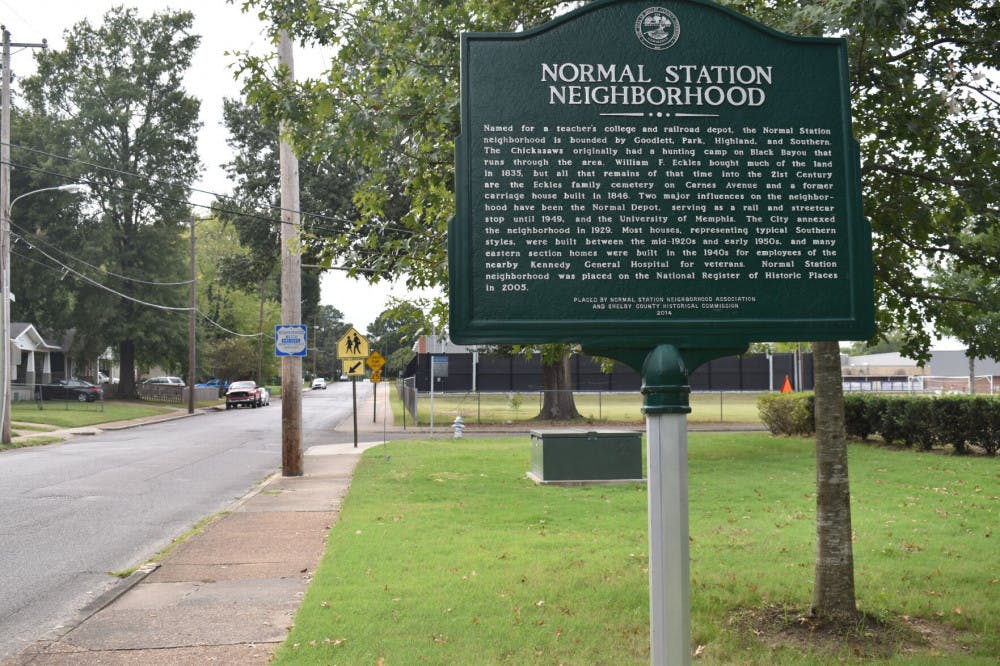The Normal Station neighborhood is home to a number of University of Memphis students. For many, the area offers affordable, off-campus housing that is often a step towards independence and adulthood.
The neighborhood acquired its name from the founding name of West Tennessee, which then transitioned to be named Memphis State University, and is now presently known as the University of Memphis. What made the school normal is that it was taken from the French term, ecole normale, and had come to mean a school for training teachers.
“I was the last of the graduating class at the training school, and my wife, Glenda, was the last junior class,” said David Turner. Turner has been a resident of Normal Station all his life and has been in his current house for 76 years.
West Tennessee State Normal School was dedicated to a small ceremony on September 3, 1912. Three buildings existed on campus to serve the first year's class of 200 students: the main teaching hall (now the Administration building), the women’s dormitory (renamed Mynders Hall after the school’s first president), and the president’s home (now gone, replaced by Patterson Hall).
According to the Memphis Heritage Organization, the school was a godsend to bright, but economically challenged students who could not afford expensive private education. Aside from a two-dollar registration fee, “Normal,” as students called it, was completely free to Tennessee residents. The only requirements: students had to be white, 16-years-old, and an elementary school graduate.
The couple, Glenda and David Turner, said they have witnessed drastic changes over their time of being in Normal Station. The neighborhood is bounded by three streets, Highland, Goodlett, and Southern RR and the two property lines of Marion parcels on Park Avenue.
According to John C. Rea's article, “The Normal Depot of the Southern Railway,” the construction of the Normal Depot started in 1912 and had it completed later in the year. The Southern Railway constructed the Depot on railroad property between Walker and the north side of the railroad. It is no longer there, but the foundation is visible.
“My parents owned a furniture and repair shop on Southern Avenue, just east of where the crossover is now. It was also a mall from Echols to Goodman,” Turner said. “There were a couple of shops and drug stores on Southern, where the parking garage is now – the new one.”
Normal Drug Company moved to the corner of Southern and Highland, in between Mr. Bower’s Grocery store and McLaurine’s Grocery and Restaurant. McLaurine’s, which converted to a bakery when meat was rationed during World War II, would remain a fixture of the neighborhood until its closing in the late 1990s. Business slowed down after World War II, and soon the train was not used anymore in the area.
Normal Station continued to expand in the 1900s as it connected a string of suburbs and other small towns including Cherry Road, Ridgeway, and White Station. The Harry Madison tract adjoined Southern Avenue north of Spotswood from Highland to Hughes Street and eventually one street east of Eccles. Later, Civil engineer Richard Huston divided the Harry Madison tract to establish the Normal School subdivision in early 1911.
With the construction rate, the growth of the neighborhood’s population was modest, but continued construction increased the population rapidly in the 1920s. Most of the population resided along Spotswood, Kearney, Carnes, and Douglass. David and Glenda Turner have been around Normal Station to see the complete changes of Normal Station.
“There should have been more coordination with the city when implementing the infrastructure, traffic control, widening the streets,” Glenda Turner said. “It is really sad that we cannot walk because of its endless business.”
In 1957, when State Teaching School gained its credibility and received university status, they changed their name. As the years went on, the geographical size grew alongside enrollment. Students needed housing, so Normal Station also grew. The university began acquiring land where student housing was, as well as different rental properties.
According to the Memphis Heritage Organization, older residents stated in a 1979 interview that “with the opening of the Normal School, it suddenly became fashionable to live on the east side of Highland. Buntyn, the older and more established railroad town one mile west, became viewed as ‘old-fashioned’ by its residents, who quickly began migrating to the new neighborhoods in Normal.”
Normal Station is the product of 160 years of Shelby County history from its earliest home, a former carriage house on Southern Place built in 1846, to its latest, built-in 1999. As for its oldest residents, some of them remain in the neighborhood in the cemetery on the street of Carnes. “Everything was for a single-family dwelling when they were growing up. Now it is rental housing with multiple housing but is still the best neighborhood and I would not live anywhere else,” said Glenda Turner.
Normal Station is a neighborhood dominated by students. The neighborhood resides south of the railroad tracks that dissect campus.






